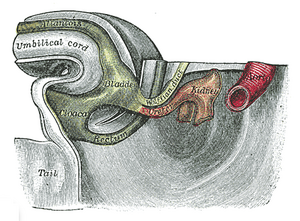Bladder and urethra development
Bladder development[edit | edit source]
In the 4th to 7th week of development, the septum urorectale (layer of mesoderm) divides the cloaca into the front lying sinus urogenitalis'' and the back canalis analis. The sinus urogenitalis has 3 parts.
Parts of the sinus urogenitalis[edit | edit source]
- Upper part - the largest, the base of the Urinary Bladder. Initially connected with the allantois urachus, in the definitive state it leads from the apex of the bladder to the navel ligamentum umbilicale medianum.
- Middle part – pelvic section. It is a narrow canal, from which the pars prostatica et pars membranacea urethrae arise in men, and the entire urethra in women.
- Lower part – spongy part. It is flattened on the sides. In men it gives rise to pars spongiosa urethrae in addition to pars glandis, in women it gives rise to vestibulum vaginae.
Development of own bladder[edit | edit source]
During development, the caudal parts of the mesonephric duct are drawn into the bladder wall. As a result, the ureters, which originally branched off from the mesonephric duct, open separately into the bladder. As the kidneys ascend, their mouths move cranially. The mouths of the mesonephric ducts converge. In men, it then opens into the pars prostatica urethrae as ductus ejaculatorii. In women, the mesonephric duct disappears above the ureteral bud gap. The mucous membrane of the trigonum vesicae arises from the indentation of the mesonephric duct, which is of mesoderm origin, so this mucosa is also of mesoderm origin. Later, however, it is replaced by the surrounding entoderm epithelium, so that the definitive bladder mucosa is entirely of entoderm origin.
Development of the urethra[edit | edit source]
The epithelium of the urethra originates from the endoderm, the ligament and smooth muscle originates from the mesoderm of the splanchnopleura. At the end of the 3rd month, the epithelium of the pars prostatica urethrae proliferates and forms protrusions into the mesenchyme around the urethra. In men, these protrusions form the basis of the prostate, in women they form the urethral and paraurethral glands.
Developmental defects of the bladder[edit | edit source]
Persistence of allantois[edit | edit source]
If part of the lumen of the allantois persists, an ureteral fistula can occur, where the connection between the bladder and the navel is preserved and urine can therefore drain into the navel. If only a small section persists, which is located in the course of the ligamentum umbilicale medianum and does not communicate with either the bladder or the navel, a urachus cyst is formed, which is filled with secretions from the epithelium. Persistence of the upper part is called sinus urachi.
Bladder Exstrophy[edit | edit source]
Bladder exstrophy is a defect of the anterior abdominal wall in which the bladder mucosa is exposed. This defect may be caused by insufficient migration of mesoderm cells to the area between the umbilicus and tuberculum genitale and subsequent rupture of the thin layer of ectoderm.
Cloacal exstrophy[edit | edit source]
This is an even more serious defect than bladder exstrophy. Insufficient migration of the mesoderm also affects the area of the caudal groove. As a result, not only bladder exstrophy occurs, but also spinal defects, imperforate anus, and usually also omphalocele.
Links[edit | edit source]
Related Articles[edit | edit source]
References and sources[edit | edit source]
- SADLER, Thomas, W. Langman's Medical Embryology. 1. Czech edition. Grada, 2011. 414 pp. ISBN 978-80-247-2640-3.

